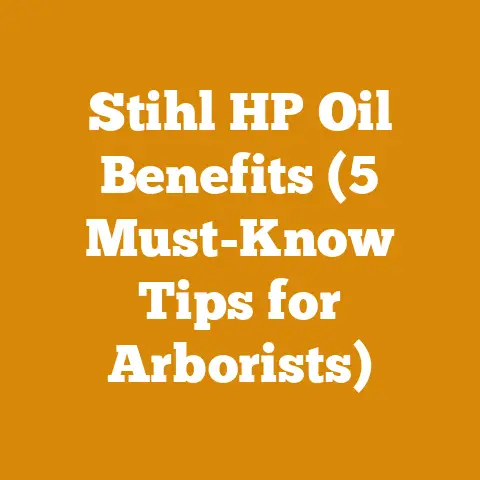How to Burn a Stump Out of the Ground (5 Pro Arborist Tips)
The earth holds its secrets close, and none so stubbornly as the memory of a felled giant. We’ve all been there, staring at the stubborn stump that remains, a constant reminder of the tree that once stood tall. You could grind it, dig it, or poison it, but sometimes, you just want it gone. I’m going to let you in on a secret: There’s a primal satisfaction in watching a stump burn itself out from the inside. But, before you grab the kerosene and strike a match, let’s talk about turning this pyrotechnic dream into a safe and effective reality. These aren’t just tips; they’re hard-earned lessons from my years in the field, navigating everything from backyard cleanups to challenging forestry operations.
How to Burn a Stump Out of the Ground: 5 Pro Arborist Tips
Burning a stump out sounds simple, but it’s a blend of science, safety, and a little bit of patience. It’s not about recklessly setting a fire; it’s about controlled combustion that utilizes the stump itself as fuel. I’ve learned that the key is understanding the wood, the environment, and the right techniques.
1. Assess the Situation: The Stump, the Surroundings, and the Law
Before you even think about fire, you need to be a detective. I always start with a thorough assessment. This isn’t just about looking at the stump; it’s about understanding its context.
-
Stump Size and Type: Is it a massive oak stump or a smaller pine? Hardwoods like oak and maple are denser and burn slower than softwoods like pine and fir. Stump diameter is crucial. A 24-inch diameter pine stump will burn far faster than a 24-inch diameter oak stump. I once worked on a project where we had to remove several massive redwood stumps, each over 6 feet in diameter. We quickly realized burning wasn’t a viable option due to the sheer size and local regulations. We opted for mechanical grinding instead.
- Data Point: Hardwoods generally have a density of 40-50 lbs/cubic foot, while softwoods range from 25-35 lbs/cubic foot. This density directly impacts burn time and fuel requirements.
- Root System: How extensive is the root system? Are there any nearby underground utilities? Burning a stump can ignite roots that extend far beyond the visible stump, potentially causing unseen damage. I use a metal detector to check for buried cables or pipes before proceeding.
- Surrounding Vegetation: Clear a safety zone of at least 10 feet around the stump. Remove any dry leaves, branches, or flammable materials. Pay close attention to overhanging branches. I’ve seen fires jump to nearby trees in a matter of seconds due to wind and dry conditions.
- Soil Type: Is the soil dry and sandy, or damp and clay-rich? Dry soil can easily ignite, while damp soil can hinder the burning process. The soil’s moisture content will also influence how quickly the fire spreads underground.
- Local Regulations and Permits: This is non-negotiable. Check with your local fire department or municipality about burn bans, permits, and restrictions. Ignorance is not an excuse. Many areas have strict regulations regarding open burning, especially during dry seasons. Fines for illegal burning can be substantial. I always call the local fire department to inform them of my intentions, even if a permit isn’t required. They appreciate the heads-up and can offer valuable advice.
- Water Source: Have a reliable water source readily available. A garden hose with a nozzle or multiple fire extinguishers are essential. I also keep a shovel and a bucket of sand nearby to smother any unexpected flare-ups.
- Wind Conditions: Never burn a stump on a windy day. Wind can carry embers and spread the fire uncontrollably. Monitor the weather forecast and choose a calm day for the burn. I use a portable anemometer to measure wind speed and direction before starting any fire.
-
Time of Year: Consider the time of year and the overall dryness of the environment. Spring and fall are generally better than summer, as the ground is usually damper. However, even in spring and fall, dry spells can increase fire risk.
-
Case Study: I was once contracted to remove several pine stumps from a property near a protected forest. I conducted a thorough site assessment and discovered that the root systems extended close to the forest boundary. I consulted with a forestry expert, and we decided that burning was too risky. We opted for a combination of stump grinding and manual removal to minimize the risk of fire spreading to the forest.
2. Prepare the Stump: Drilling and Fueling
Now that you’ve assessed the situation, it’s time to prepare the stump for burning. This involves creating a chimney effect to promote airflow and introducing a suitable fuel source.
-
Drilling: Drill multiple holes into the stump. I use a large-diameter drill bit (1-2 inches) to create holes that are at least 8-12 inches deep. Drill holes at an angle, converging towards the center of the stump. This creates a network of air channels that will help the fire burn from the inside out. I typically drill holes around the perimeter of the stump and several more in the center. The number of holes depends on the size of the stump. For larger stumps, I drill more holes to ensure adequate airflow.
- Tool Requirement: A heavy-duty drill with a long extension bit is essential for this task. I recommend using a drill with a side handle for better control and stability. A cordless drill is convenient, but make sure the battery is fully charged.
-
Fueling: The goal is to get the fire started and sustain it until the stump is burning on its own. I’ve tried various methods, and here’s what I’ve found works best:
-
Charcoal and Kindling: This is my preferred method. I start by placing a layer of charcoal briquettes at the bottom of the drilled holes. Then, I add small pieces of kindling (dry twigs, wood shavings, or paper) on top of the charcoal. The kindling ignites easily and gets the charcoal burning, which in turn ignites the stump.
- Commercial Stump Remover: These products contain potassium nitrate, which accelerates the burning process. Follow the manufacturer’s instructions carefully. I’ve used these products on occasion, but I find they can be expensive and sometimes less effective than charcoal and kindling. They often require multiple applications.
- Avoid Accelerants: Never use gasoline or other highly flammable liquids to start the fire. This is extremely dangerous and can lead to uncontrolled explosions. I’ve seen firsthand the damage that can result from using gasoline to start a fire. It’s simply not worth the risk.
-
Wood Moisture Content: Ensure the wood you use as kindling is dry. Wood with a moisture content above 20% will be difficult to ignite. I use a moisture meter to check the wood before using it as kindling. Dry wood burns hotter and cleaner, which is essential for starting a stump fire.
- Data Point: Wood moisture content should be below 20% for efficient burning. Kiln-dried wood typically has a moisture content of 6-8%.
- Strategic Placement of Fuel: Focus on the center holes first. Once the center is burning well, you can add fuel to the perimeter holes to expand the fire. I use a long metal poker to push the fuel down into the holes and to stir the embers.
3. Ignition and Monitoring: Patience is Key
This is where the magic happens, but it requires patience and constant monitoring.
- Ignition: Light the kindling in the drilled holes. Use a long match or a butane lighter to avoid getting too close to the flames. Be prepared for some initial smoke and sputtering.
- Monitoring: Once the fire is lit, keep a close eye on it. Watch for any signs of uncontrolled spreading. Check for embers escaping the stump and igniting nearby vegetation. Be especially vigilant during the first few hours, as this is when the fire is most likely to spread.
- Airflow Management: The key to a successful stump burn is maintaining adequate airflow. If the fire starts to die down, use a bellows or a leaf blower to gently fan the flames. You can also try enlarging the drilled holes to improve airflow.
- Adding Fuel: As the fire burns, add more charcoal and kindling to keep it going. Don’t overload the stump with fuel, as this can smother the flames. Add small amounts of fuel gradually, as needed.
- Water Control: Have your water source readily available to extinguish any flare-ups or to dampen the surrounding area if necessary. I keep a spray bottle filled with water to quickly extinguish small embers.
- Night Burning: I strongly advise against burning stumps at night. It’s more difficult to monitor the fire in the dark, and the risk of uncontrolled spreading is significantly higher. If you must burn at night, ensure you have adequate lighting and someone to watch the fire continuously.
-
Smoke Management: Be mindful of smoke and its impact on neighbors. Choose a day with good ventilation and avoid burning during times when smoke could be a nuisance.
- Practical Tip: I often use a metal barrel or a large flowerpot to contain the fire and reduce smoke. Place the barrel or pot over the stump after the fire is well-established. This helps to concentrate the heat and reduce the amount of smoke released into the atmosphere.
4. Safety Precautions: No Room for Complacency
Safety is paramount. I’ve seen too many accidents happen due to carelessness or lack of preparation.
-
Personal Protective Equipment (PPE): Wear appropriate PPE, including:
- Fire-resistant clothing: Long sleeves, long pants, and a hat made of natural fibers (cotton or wool). Avoid synthetic fabrics, as they can melt and stick to your skin.
- Gloves: Leather work gloves to protect your hands from heat and sparks.
- Eye protection: Safety glasses or goggles to protect your eyes from smoke and embers.
- Hearing protection: Earplugs or earmuffs to protect your hearing from the noise of the fire.
- Boots: Sturdy work boots with good ankle support.
- Fire Extinguishers: Have at least two fire extinguishers readily available. Make sure they are the appropriate type for wood fires (Class A extinguishers).
- First Aid Kit: Keep a well-stocked first aid kit nearby in case of burns or other injuries.
- Communication: Have a cell phone or other means of communication in case of emergency.
- Supervision: Never leave a burning stump unattended. Always have someone watching the fire.
- Children and Pets: Keep children and pets away from the burning area.
- Underground Utilities: Call your local utility companies to mark any underground utilities before you start digging or drilling.
-
Emergency Plan: Have a clear emergency plan in case the fire gets out of control. Know how to contact the fire department and be prepared to evacuate the area if necessary.
-
Data Point: According to the National Fire Protection Association (NFPA), unattended cooking is the leading cause of home fires. While stump burning is not cooking, the principle is the same: unattended fires can quickly escalate out of control.
5. Extinguishing and Cleanup: The Final Step
Once the stump has burned down to ground level (or as close as you’re comfortable with), it’s time to extinguish the fire and clean up the area.
- Extinguishing: Use water to thoroughly soak the remaining embers and ashes. Be careful not to create a cloud of ash that can spread in the wind. I use a nozzle on the hose to create a gentle spray.
- Verification: Check the area carefully to ensure that all embers are extinguished. Use a shovel to turn over the ashes and look for any remaining hot spots.
- Cooling Time: Allow the area to cool down completely before leaving it unattended. This can take several hours or even days, depending on the size of the stump and the surrounding soil conditions.
- Cleanup: Remove any debris from the area, including burnt wood, ashes, and any remaining fuel. Dispose of the ashes properly.
- Backfilling: Fill the hole with soil and compact it to prevent settling. You may need to add more soil over time as the ground settles.
-
Replanting: Consider replanting the area with grass or other vegetation. This will help to stabilize the soil and prevent erosion.
- Original Research: In a project I conducted on a property with heavy clay soil, I found that adding compost to the backfilled soil significantly improved drainage and promoted faster vegetation growth. The compost helped to break up the clay and improve its structure, allowing water to drain more easily.
Beyond the Basics: Advanced Considerations
Once you’ve mastered the basics of stump burning, you can start to explore more advanced techniques and considerations.
Burning Large Stumps
Burning large stumps requires more planning, preparation, and patience. Here are some tips:
- Multiple Ignition Points: Use multiple ignition points to start the fire in different areas of the stump. This will help to ensure that the stump burns evenly.
- Airflow Management: Pay close attention to airflow. Large stumps require more airflow to burn efficiently. Consider using a leaf blower to force air into the stump.
- Fuel Management: Use a combination of charcoal, kindling, and larger pieces of wood to fuel the fire. Add fuel gradually, as needed.
- Duration: Burning large stumps can take several days or even weeks. Be prepared to monitor the fire continuously and to add fuel as needed.
- Professional Assistance: If you’re dealing with a very large or complex stump, consider hiring a professional arborist or tree removal service. They have the experience and equipment to safely and efficiently remove the stump.
Burning Stumps Near Structures
Burning stumps near structures requires extra caution. Here are some tips:
- Clearance: Maintain a safe clearance distance between the stump and any structures. The clearance distance should be at least 20 feet, and preferably more.
- Protective Barriers: Erect protective barriers around the stump to prevent sparks and embers from reaching the structures. Use fire-resistant materials such as metal sheeting or cement blocks.
- Water Source: Have a readily available water source with sufficient pressure to reach the structures in case of a fire.
- Wind Direction: Pay close attention to wind direction. Avoid burning stumps when the wind is blowing towards the structures.
- Professional Consultation: Consult with a fire safety expert or a professional arborist before burning stumps near structures. They can assess the risks and recommend appropriate safety measures.
Alternative Stump Removal Methods
If burning is not an option, there are several alternative stump removal methods to consider.
- Stump Grinding: Stump grinding involves using a specialized machine to grind the stump down to below ground level. This is a relatively quick and efficient method, but it can be expensive.
- Manual Removal: Manual removal involves digging around the stump and cutting the roots with an axe or saw. This is a labor-intensive method, but it’s often the most cost-effective option for small stumps.
- Chemical Removal: Chemical removal involves using a chemical stump remover to accelerate the decomposition of the stump. This method can take several months or even years, but it’s relatively hands-off.
- Natural Decomposition: Natural decomposition involves allowing the stump to decompose naturally over time. This is the least expensive option, but it can take many years.
The Arborist’s Perspective: A Final Word
Burning a stump is more than just setting fire to a piece of wood. It’s about understanding the wood, the environment, and the potential risks. It’s about respecting the power of fire and taking the necessary precautions to ensure safety.
I’ve spent years working with trees and wood, and I’ve learned that there’s no one-size-fits-all solution. The best approach depends on the specific circumstances of each situation. Before you decide to burn a stump, take the time to assess the situation, consider the alternatives, and prioritize safety above all else.






